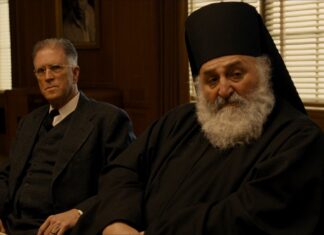By Muriel Mirak-Weissbach
Special to the Mirror-Spectator
BERLIN — How can a film about the Genocide be good? How can one shape the representation of such a crime against humanity into a work of art? And how can one do that without reducing the magnitude of the horror or sacrificing historical veracity? The Turkish-German filmmaker Fatih Akin has succeeded with his work, “The Cut,” now playing in movie theatres across Germany.
The plot line is straightforward. Nazareth Manoogian, a young blacksmith from Mardin in south Anatolia, is awakened one night in 1915 by gendarmes who whisk him and his brother-in-law away from their terror-stricken families, saying they must serve in the Ottoman army. Instead the men must work as slave laborers in chain gangs of work battalions. Those who refuse the offer to regain freedom by converting to Islam, are lined up for execution. The order “not to waste a bullet” means their throats are to be slit. Nazareth alone survives because, as his would-be executioner, an ex-convict released from prison to serve in the killer squads, tells him, “I am a thief, but not a murderer.” He receives a cut in the throat (whence the name of the film), but survives, albeit having lost the power of speech. The two join a group of deserters, then, after he learns that his family has been deported to Ras al-Ayn, he leaves in hopes of finding them.
Thus begins the odyssey which makes up the rest of the saga. In a death camp in Ras al-Ayn he finds his sister-in-law, mortally ill, and bends to her plea for release from suffering by hastening her death. Having learned from her that his twin daughters, Lusine and Arsine, survived among Bedouins, he wanders on, finally reaching Aleppo with the help of an Arab soap manufacturer who smuggles him into the city and gives him shelter. In his search among the orphanages that had taken in Armenian children, Nazareth finally happens upon the one that had sheltered his girls and then arranged for their transfer to Cuba, where they were to find worthy husbands. He recognizes them in a photo hung on the wall, a photo which will guide his search. He works his way to Cuba aboard a ship and finds out in Havana that the marriages, arranged by the wife of a barber, never took place, because one prospective husband refused to wed Lusine, who had been lamed by a broken leg, and her twin sister Arsine preferred to stay with her. The two girls reportedly have moved on to Minneapolis, where they found employment as garment workers. Nazareth, sure to be refused entry to the U.S. because of his disability, connects with a human trafficker and steals money to finance his boat journey. From Florida he makes his way, through Tampa and Tallahassee, to Minneapolis, with whatever means available: on foot, as a stowaway on trains, whatever. When he finds the garment factory, whose address he has, he learns that the girls have left for North Dakota. The trek continues, through wintry snow and ice-cold temperatures. At long last, in a remote village where many Armenians had found refuge, Ruso, he finds his daughter Lusine. Arsine has died, and his journey ends with their visit to her grave.








